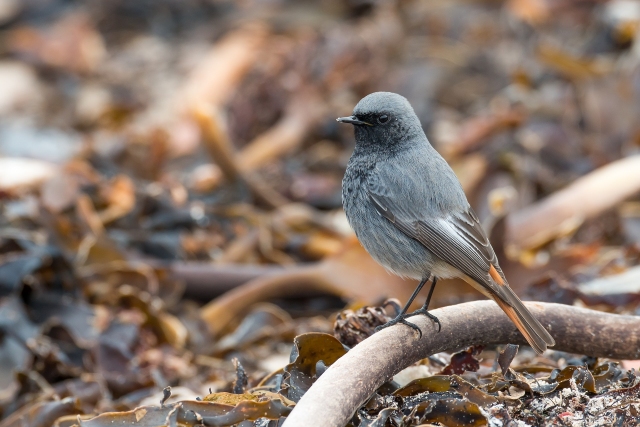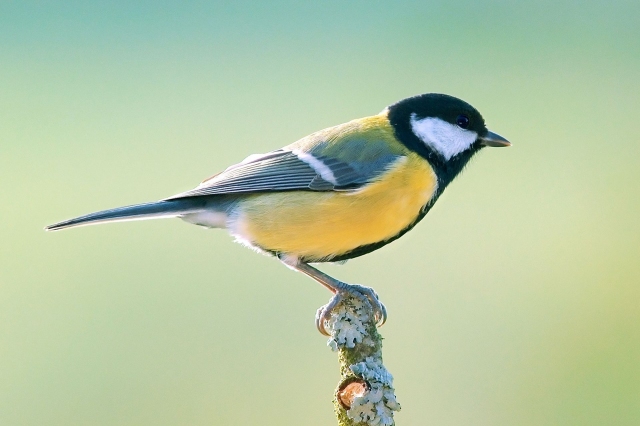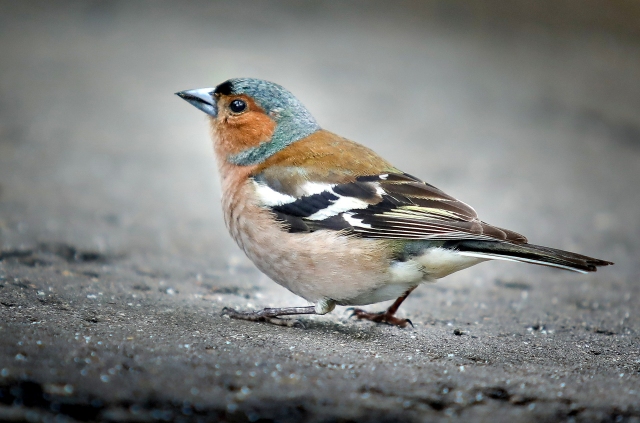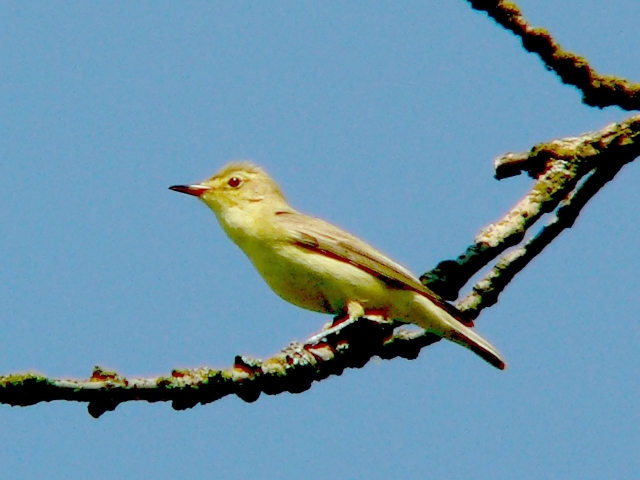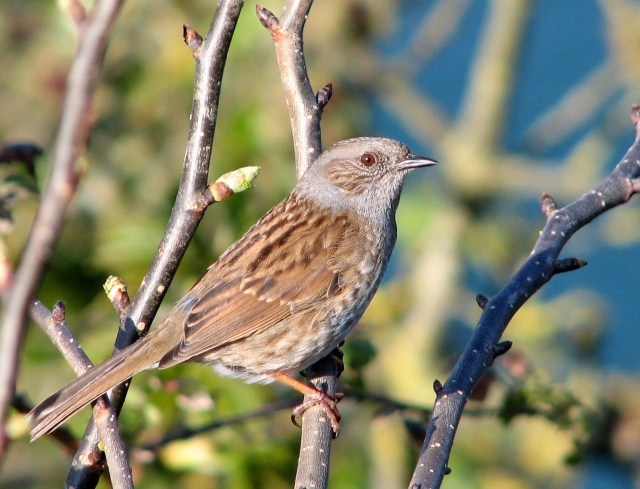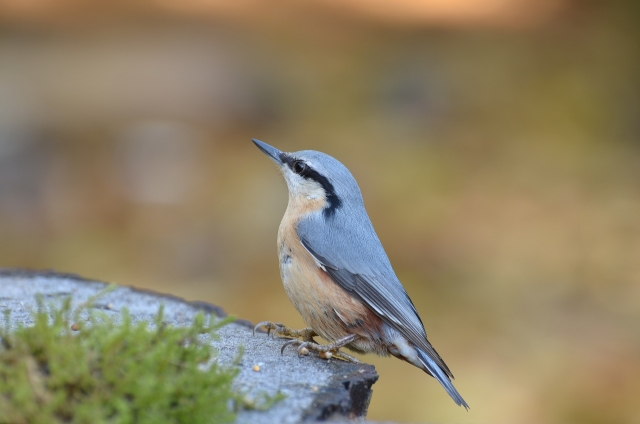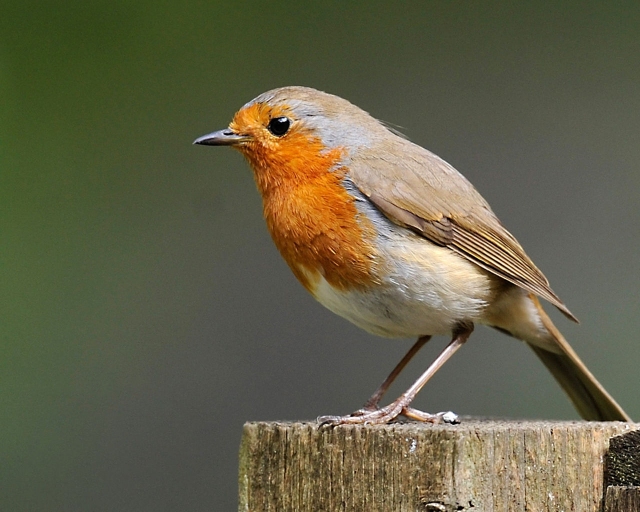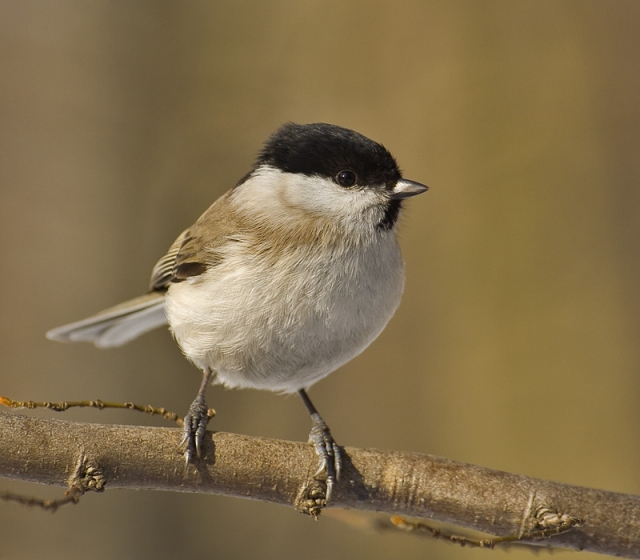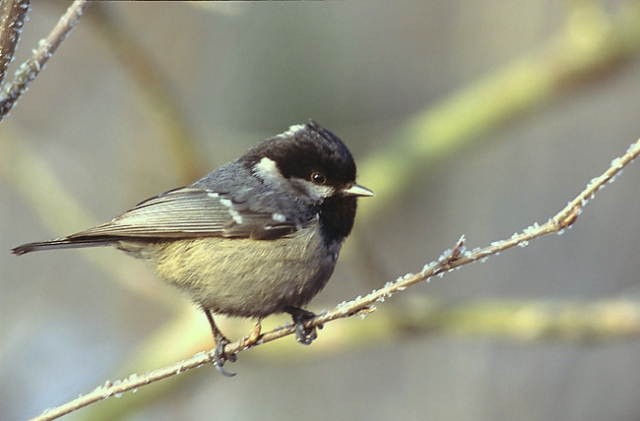Florian Heigl
Black redstart
Description
With a body length of 14 to 15 cm, the black redstart is slightly smaller and, above all, slimmer than the house sparrow. The eponymous characteristic of the genus is the rust-orange coloured uppertail coverts and tail feathers, whereby in the black redstart the middle pair of tail feathers is dark brown. This feature is present in all dresses in both male and female. The brown-black beak is relatively long, broad at the base and ringed by rather long beak bristles. The black, slender legs are strikingly long, the perching posture is upright. The weight is between 14 and 20 grams, on average 16.2 grams. The wings are relatively long, the wing length of Central European representatives of the species ranges from 85 to 91 mm, the wingspan is about 26 cm.
The upperparts of adult males are dark slate grey during the breeding season. The forehead is black, sometimes with a white forehead patch. The reins, cheeks and the underpart from the chin to the belly are black, the underparts are lighter and greyer. The dark brown-grey primaries and secondaries have a white fringe, which is particularly evident on the middle secondaries, forming a white wing patch. This is only visible on a sitting bird and may be barely visible in summer. In autumn and winter, males appear slightly lighter overall due to grey feather fringes.
Females are much more inconspicuous than males. The rump and uppertail coverts appear less bright than the male and more reddish brown than rusty orange. On top, females are uniformly grey-brown in colour, only the middle and underbelly are blurred grey-white and thus lighter.
distinction between black redstart and common redstart
In Europe, the closely related commonn redstart (Phoenicurus phoenicurus) breeds alongside the redstart. Adult males of the common redstart can be easily distinguished during the breeding season by their white forehead, black facial mask and rust-orange rather than brown-grey underparts. It is more difficult to distinguish females; those of the common redstarts differ from female black redstarts by their pale, usually whitish-isable throat and much lighter rusty-orange to isabel-brown underparts.
Habitat
As the only bird species of the Western Palearctic, the black redstart inhabits all altitudinal zones from sea level to the alpine, sporadically even to the lower nival altitudinal zone. The species' primary habitats already cover a wide range of dry to moist mountain and rocky regions; in addition, the black redstart now colonises a large number of man-made habitats.
Common to all primary habitats is the open, largely clear character and the absence of higher, dense vegetation. These habitats have at least individual rocks or boulders that are important as breeding sites or waiting areas.
The range of secondary habitats colonised by the black redstart is extraordinarily broad, and the connection to the primary habitats, although not obvious in all cases, is recognisable on closer inspection. A key factor of these habitats is the existence of at least single clear-cut, short-grassed or vegetation-poor areas, which are preferentially hunted. In its choice of nest sites, the black redstart is markedly flexible and insensitive to disturbance. There are secondary habitats inside and outside human settlements. Examples include gravel pits, quarries, vineyards interspersed with retaining walls and virtually all types of residential, commercial and industrial sites. In Europe, settlements are now thought to host 90 per cent of the total population.
Open, clear habitats are also preferred as resting places after the breeding season and during migration. Settlement birds also use surrounding cultivated land in late summer, especially fallow fields and harvested maize fields. Riverbanks are particularly popular resting places during migration, especially in bad weather. Reeds and reed beds, on the other hand, are avoided despite their abundance of food and their open to semi-open character.
The text is a translation of an excerpt from Wikipedia (https://de.wikipedia.org/wiki/Hausrotschwanz). On wikipedia the text is available under a „Creative Commons Attribution/Share Alike“ licence. Status: 03 November 2021
Great tit
Description
With a body length of 13-15 cm, the great tit belongs to the larger tit species and is the largest tit in Europe. The wing length of males is between 71 and 82 mm, of females between 69 and 81 mm. The tail length of the male is 59-66, that of the female 55-63 mm. The weight is between 14 and 22 g. The 11.5-13.5 mm long beak is relatively strong and blackish horn-coloured with slightly lighter edges. The iris is vivid reddish brown to blackish brown. The legs and feet are blue-grey to slate-grey.The sexes are very similar, but can be distinguished partly by the expression of the black breast band.
adult birds
In adult males, the top of the head, upper nape, sides of the neck, throat and a band on the middle of the breast are glossy blue-black. Cheeks and ear coverts are pure white, neatly edged by the black areas. The sides of the chest and belly are sulphur to lemon yellow. The black band in the middle widens to a deep black patch between the legs. A whitish band on the nape of the neck separates the black of the back of the head from the back and fades into a greenish yellow towards the back. Dorsal and shoulder feathers are otherwise olive green with a greyish tinge. Lower back, rump and uppertail coverts are blue-grey with a greenish tinge on the rump. Longer uppertail coverts and tail feathers are dark blue-grey. The middle pair of tail feathers bears a dark shaft line, the others black inner vanes, the penultimate also a white tip and the outer one a white outer vane, the whiteness of which extends to the middle of the inner vane. The outer sides of the tail therefore appear white. The upper wing coverts are grey-blue, with the lesser and middle coverts showing slightly duller coloured centres, the inner plumes of the greater coverts and the primary coverts showing obscured black-grey centres. The large greater coverts also show white tips forming a white wing band. The primaries, secondaries and the tertials are predominantly black-grey. The tertials are also broad and fringed with light greenish yellow with a white lace fringe. The wings, with the exception of the two outer primaries, are narrowly grey-blue fringed and white-tipped, with only faint tips on the primaries.
The female strongly resembles the male, but is duller and darker on top. The head plate is less shiny bluish and the throat patch is duller. The black band framing the cheeks on the sides of the neck is narrower and sometimes interrupted. The vertical chest band is narrower and duller in colour. It often appears messier at the edges and may be interspersed with white towards the belly. The dark belly patch is smaller and there is often more white on the undertail coverts. The grey-blue fringes of the arm wings are less conspicuous.
juvenile plumage
The juvenile plumage resembles the adult plumage, but is much less colourful. The sides of the head, the light band on the nape and the wing band are tinted yellowish or dirty white. The head plate and the sides of the neck are dark olive-brown to dark grey and without gloss. The dark grey breast band runs out on the rear breast. The wing and tail feathers are rather dark brown instead of blackish. The fringes of the upper wings and the uppertail coverts are dull olive-green instead of grey-blue. The undertail coverts are whitish. The beak, unlike adult birds, is more horn-coloured with yellow edges and beak angles, the iris is greyer.
The sexes are not easily distinguished in juvenile plumage, but the differences present in adult plumage are already apparent. For example, the dark band on the sides of the head below the cheek patch is absent in the female, and the band on the middle of the breast is very faint or absent. The wing and tails feathers appear duller or more brownish than in the male. The best distinguishing feature, however, is the fringes of the primary coverts, which are already bluish and distinct in the male, but diffuse brownish, greenish or pale grey in the female.
Habitat
The great tit breeds primarily in deciduous and mixed forests where the tree population is 60 or more years old enough to guarantee a sufficient supply of nest holes, whereby it nests remarkably more often in rotten tree stumps than in woodpecker holes. In younger forest stands it occurs only sporadically, in closed forest areas it colonises only the marginal areas, valley locations are preferred to mountain forests. The preferred forest composition can vary regionally; in western Central Europe the highest population densities are found in oak forests, whereas further east they are found in mixed coniferous forests. Relatively low stand densities are achieved in pure beech forests; pine and spruce forests are generally only very sparsely populated.
However, due to its great adaptability, the great tit can also be found in numerous other habitats with old trees or artificial nest holes. In addition to copses, groves, hedgerows with interspersed trees, parks, cemeteries, olive groves and orchards, it also inhabits gardens or green spaces with individual trees in the middle of towns. At higher altitudes, in cleared cultivated landscapes or arid areas, it is particularly tied to human settlements.
Outside the breeding season, the great tit occurs in all conceivable habitats and has also been found, for example, in treeless steppe areas.
The text is a translation of an excerpt from Wikipedia (https://de.wikipedia.org/wiki/Kohlmeise). On wikipedia the text is available under a „Creative Commons Attribution/Share Alike“ licence. Status: 11 November 2021
House martin
Description
The house martin has a body length of about 13 cm and weights between 16 and 25 grams. It is thus smaller and slimmer than a sparrow and belongs to the medium-sized birds within the swallow family.
The head, back, upper side of the wings and tail of adult house martins are blue-black. The entire underparts of the body and the rump contrast with this with a pure white to floury white colouration. The short legs and feet are also white feathered. The toes and the few unfeathered parts of the legs are pale flesh-coloured. Compared to the barn swallow, the tail is less forked; strongly elongated outer feathers are absent. The eyes are brown; the beak is short and black.
Occasionally, house martins also include whites whose plumage is either completely white or in which the white parts are much more extensive than in normally coloured house martins. The literature describes individuals in which only the head was normally coloured and the rest of the body was feathered in white, or in which only the right wing feathers, wing coverts and primaries were pure white.
Juveniles can be distinguished from adults by their brownish to brownish-black upperparts, which only shine bluish-black in some areas. The wings are also brownish and still lacking in lustre. The throat and flanks are grey feathered. The most striking distinguishing feature is the grey rump (pure white in adults). It has a speckled appearance as its dark brown feathers have white tips.
Habitat
House martins are originally breeding birds that nest on vertical rock cliffs. Breeding colonies in such natural places still exist today. In its European range, however, the species is predominantly a synanthropic bird, using the open and populated cultural landscape as its habitat. Even in the European range, house martins still settle at high altitudes. In Austria, a colony of house martins has been documented on the Großglockner at an altitude of 2450 metres.
House martins depend on open areas with low vegetation. This enables them to hunt aerial plankton even when it flies low due to rainy or stormy weather. The proximity of larger bodies of water is also necessary to find suitable nesting material. There are different statements in the literature about how pronounced the cultural succession behaviour of the house martin is, especially in comparison to the barn swallow. High levels of air pollution may be responsible for house martins avoiding cities in some regions.
The text is a translation of an excerpt from Wikipedia (https://de.wikipedia.org/wiki/Mehlschwalbe). On wikipedia the text is available under a „Creative Commons Attribution/Share Alike“ licence. Status: 11 November 2021
Common chaffinch
Description
The common chaffinch can reach a body length of 14 to 18 cm and weights between 18 and 25 grams. Regardless of sex, common chaffinches have a conspicuous white shoulder patch, a white wing band and white outer tail feathers. Otherwise, there is a striking sexual dimorphism.
In males, the underparts and the sides of the head are brownish pink to reddish brown. The top of the head, the nape of the neck and the sides of the neck are a striking greyish-blue in summer and more brownish-grey in winter. The forehead is black, the back is chestnut brown and the rump is greenish. The male's beak is steel blue in spring, otherwise horn-coloured. Females are olive grey on the upperparts and slightly lighter on the underparts. The female's beak is light brown to horn-coloured all year round.
Newly hatched common chaffinches initially have pale smoky grey down on the upperparts of the body, wings, thighs and belly. The skin is flesh pink. The throat is deep pink, the beak bulges are white or cream-coloured to yellowish. Juveniles resemble adult females, but their head and body feathers are slightly shorter and softer, and the tail feathers are narrower and more pointed.
Habitat
The common chaffinch is widespread in Europe and North Africa, but also in Western Asia, where it lives mainly in forests, but also in parks and large gardens up to about 1500 metres above sea level. It is one of the most common songbird species in Europe.
The habitat of the common chaffinch is forests, thickets, hedges, gardens and large orchards.
The text is a translation of an excerpt from Wikipedia (https://de.wikipedia.org/wiki/Buchfink). On wikipedia the text is available under a „Creative Commons Attribution/Share Alike“ licence. Status: 16 November 2021
Icterine warbler
Description
Icterine warblers are quite small, slender songbirds with rather large heads, quite strong beaks, long wings and relatively short tails. They are quite strikingly coloured compared to other tree warblers, with a brownish olive-green upperparts and a pale yellow underpart when freshly plumaged, but otherwise, like all warblers, they do not show any conspicuous markings. The sexes do not differ in size and colouration.
With a body length of 12.0 to 13.5 cm and a weight of 11 to 19 g, the species is clearly smaller than a house sparrow and only about half as heavy. In adult birds, the entire upperparts of the rump as well as the neck and head are a brownish olive-green. The wing region, the short over-eye stripe and the eye area are pale yellow. The middle coverts are dark brown, the greater coverts olive brown. The wings are blackish brown, the primaries and the tertials show narrow, the secondaries broader yellowish fringes on the outer vanes and yellowish tips. The tail feathers are dark brown with very narrow lighter brown edges. The entire underpart of the rump, the underwing coverts as well as the undertail coverts are pale yellow, the more intense yellow colouring often being restricted to the throat and forechest. Breast sides and flanks show a brownish tinge.
The iris is dark brown. The beak is clearly bicoloured; the upper beak is dark brown, the entire lower beak yellowish. The legs are leaden grey.
In juvenile plumage the upperparts are more brown-grey and less olive, the underparts paler yellow with more extensive brown flanks. The wings, tail feathers and the coverts have warm brownish edges.
Habitat
The icterine warbler inhabits a wide range of habitats with loose trees and higher shrubbery, preferring multi-layered deciduous woods with a low degree of cover in the upper layer. In Central Europe, the species inhabits riparian forests and damp mixed deciduous forests, but also copses, hedgerows, cemeteries and semi-natural parks.
The text is a translation of an excerpt from Wikipedia (https://de.wikipedia.org/wiki/Gelbspötter). On wikipedia the text is available under a „Creative Commons Attribution/Share Alike“ licence. Status: 17 November 2021
European dunnock
Description
The European dunnock is just under 15 cm long and thus somewhat smaller than a sparrow. It weighs an average of 20 grams. The breast and head are lead-grey to slate-grey; the back and wings are rich dark brown with black stripes. The dark, thin beak is characteristic. Males and females look alike.
Habitat
The European dunnock lives on forest edges, in gardens, parks and bushes, in the Alps also in the krummholz zone. It reaches its highest settlement density in areas densely covered with young spruce trees. Here there can be between five and fifteen breeding pairs per 10 hectares. On coniferous forest areas with higher coniferous tree cover, the settlement density drops to two pairs. Comparable values are also achieved for mixed and deciduous forests.
The text is a translation of an excerpt from Wikipedia (https://de.wikipedia.org/wiki/Heckenbraunelle). On wikipedia the text is available under a „Creative Commons Attribution/Share Alike“ licence. Status: 17 November 2021
Eurasian nuthatch
Description
The Eurasian nuthatch reaches a body length of 12 to 14.5 cm. The body is stocky with a large head, very short neck and short tail. The beak is long, pointed and grey in colour. The upperparts are blue-grey and the underparts white to ochre or rusty-red in colour, depending on the subspecies. There are large white spots on the uppertail coverts, which are always reddish brown. The Eurasian nuthatch has a black eye stripe. The cheeks and throat are white. The iris is black and the legs are orange-yellow.
Habitat
Closely tied to forests with old stands of trees.
The text is a translation of an excerpt from Wikipedia (https://de.wikipedia.org/wiki/Kleiber_(Art)). On wikipedia the text is available under a „Creative Commons Attribution/Share Alike“ licence. Status: 17 November 2021
European robin
Description
The European robin is roundish in shape with long, thin legs. The orange-red throat, forehead and forechest are easy to recognise and allow easy identification. Feet and iris are dark brown, the beak is black-grey to brown-black. There are three to four beard bristles above each corner of the beak. The size is about 13.5 to 14 cm. The wingspan is 20 to 22 cm and the body weight is usually 15 to 18 grams.
Merkmale ??
The orange-red colouration of adult birds extends from the forehead and throat to the forechest and also includes the sides of the head and neck, the patch being most pronounced on the breast. On the forehead the orange colouration is less distinct and fringed with ash-grey. The upperparts are olive-brown, but in spring it turns greyish due to wear of the outer feather fringes. The white underparts are bordered by the light olive-brown sides of the body. While the uppertail coverts are yellowish brown, the undertail coverts are cream coloured. The tail feathers are dark brown with a yellow-grey outer vane fringe. Primary and greater coverts are large with rusty brown tips. The underwing coverts are greyish white to light brown in colour.
Habitat
The European robin is native to riparian forests, deciduous, mixed and coniferous forests, provided the shrub layer is not too dense and there is a rich ground fauna. It can also be found in bushes, hedges and undergrowth. It often lives in an area close to water. The European robin prefers shady and relatively humid areas to dry and hot areas. In the mountains it can be found up to 2600 m altitude. Its habitat also includes parks, cemeteries, copses and gardens.
The text is a translation of an excerpt from Wikipedia (https://de.wikipedia.org/wiki/Rotkehlchen). On wikipedia the text is available under a „Creative Commons Attribution/Share Alike“ licence. Status: 17 November 2021
Marsh tit
Description
With a body length of 11.5 to 13 cm, the marsh tit is intermediate in size between the great tit and the blue tit.
The beak is blackish with lightened edges (possibly in contrast to the willow tit). The iris is dark to blackish brown. The glossy black head cap on adults extends over the forehead and crown, down to the middle of the eye and back into the nape. This contrasts with the white cheeks and ear coverts. The sides of the neck are brownish white. The chin and middle of the throat are black, with some of the feathers finely tipped with white. The upperparts are brown-grey, but often slightly lighter and warmer beige on the rump. The dirty white underparts are pale beige, especially towards the flanks and undertail coverts. The dark brown-grey primaries and secondaries are narrowly brown on the outer vane and fringed with white on the inner vane. The primary coverts are also dark brown-grey, the tertials dull brown-grey. Axle feathers and underwing coverts are white with a beige tinge. The tail feathers are dark brown with an olive-brown fringe on the outer vane; the outer fringe of the outer ones is lightened to whitish. Legs and feet are bluish grey to slaty.
Birds in juvenile plumage are recognisable by their dull sooty-black cap, brown-black throat patch, greyer upperparts and whiter, barely beige underparts.
The marsh tit is very similar to the willow tit. The best way to tell them apart is by their calls and song, but with a little practice they can also be distinguished by their external features. In the willow tit the head is a dull sooty black and the white fringes of the secondaries form a light field on the folded wing. Often the throat patch is much narrower in the Marsh Tit and the cheeks are less pure white. The marsh tit also appears more small-headed and round-headed overall. Other distinguishing features can vary greatly geographically. In Central Europe, the differences are slight. Here, willow tits are more conspicuous for their warm beige flanks, while marsh tits appear more "colourless".
Habitat
The marsh tit prefers deciduous forests or mixed deciduous forests rich in variety and borderlines, with a large stock of old wood, sufficient deadwood and sparse undergrowth. In Central Europe, it typically occurs in mixed forests of oak and beech, but also in floodplain and marsh forests, field copses, orchards, parks, larger gardens with old trees or cemeteries. In pure coniferous or beech forests it is usually found only rarely or in marginal areas.
The name "marsh tit" is misleading, as it is by no means bound to marshy habitats. Although it reaches high settlement densities in wet forests, it avoids sites that are too wet, as well as those that are too dry or nutrient-poor. While the willow tit is usually more common in the wooded and semi-open landscapes of the floodplains, the marsh tit predominates in the closed woodland forms of the lowlands and hill country. In contrast to the willow tit, it can sometimes be found in suitable habitats within cities.
Outside the breeding season, the species is less choosy about habitats. It can often be found in coniferous woods or hedgerows in the more open countryside. It also often visits feeding sites near the edge of forests.
The text is a translation of an excerpt from Wikipedia (https://de.wikipedia.org/wiki/Sumpfmeise). On wikipedia the text is available under a „Creative Commons Attribution/Share Alike“ licence. Status: 17 November 2021
Coal tit
Description
The coal tit is about 11 cm long and weighs between 8 and 10 grams. It has a black crest with a characteristic white patch on the nape of the neck, which stands out as a white longitudinal stripe against the rest of the black plumage on the nape. It has white or whitish cheeks and a black chin patch. The underpart is yellowish to whitish with cream-coloured flanks. The upperparts are bluish grey to olive grey with a narrow double white wing band.
Habitat
The preferred habitat is coniferous forest. In mixed forests they seek out the conifers. In southern Europe, coal tits are also found in deciduous forests; in western Europe they also colonise gardens. As a result of high offspring sizes, the species tends to move into unpopulated areas. In its vast transpalearctic range, which stretches from the Atlantic coast across Eurasia to the Pacific coast, the coal tit is a common breeding bird. In Central Europe, it is found in coniferous and mixed forests from the lowlands to the tree line.
The text is a translation of an excerpt from Wikipedia (https://de.wikipedia.org/wiki/Tannenmeise). On wikipedia the text is available under a „Creative Commons Attribution/Share Alike“ licence. Status: 19 November 2021

